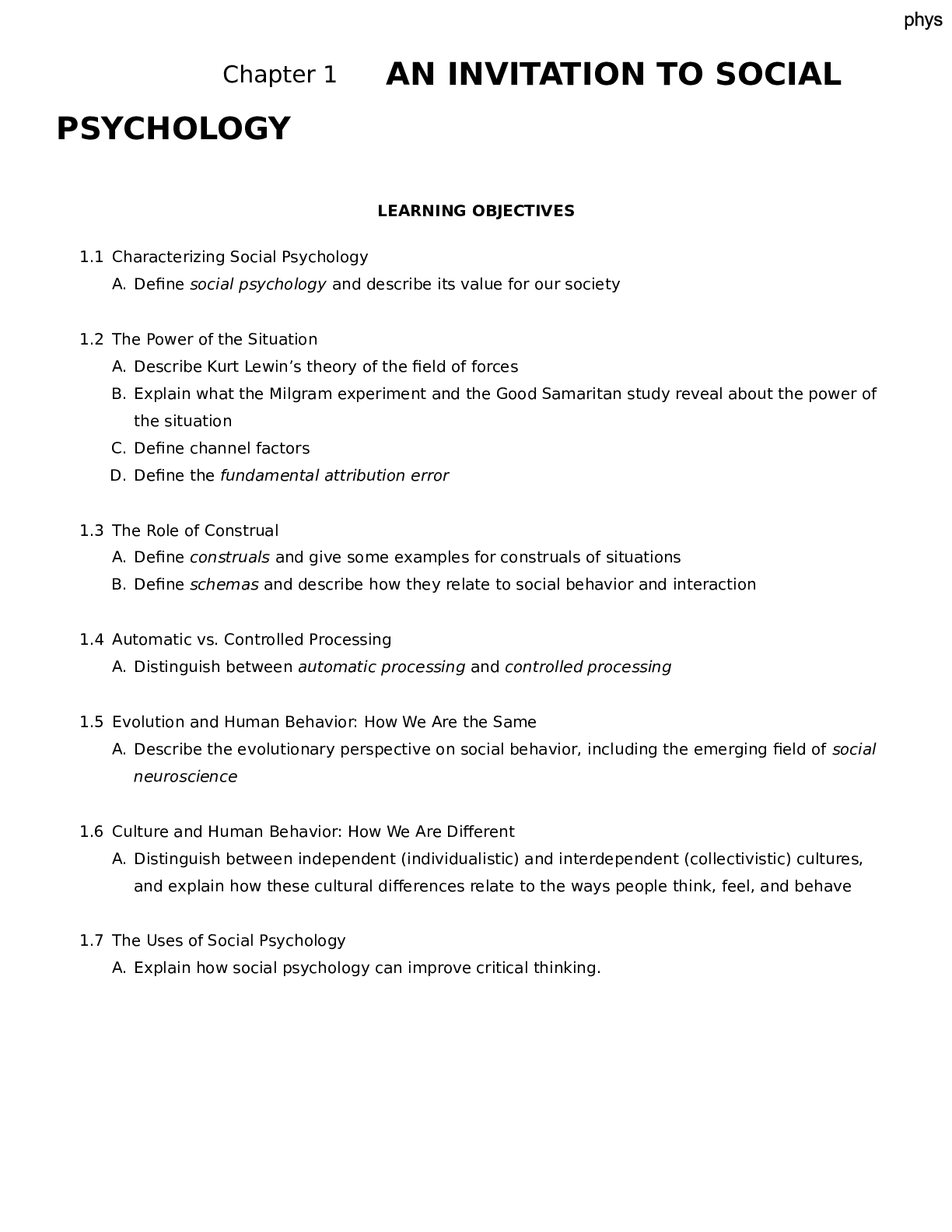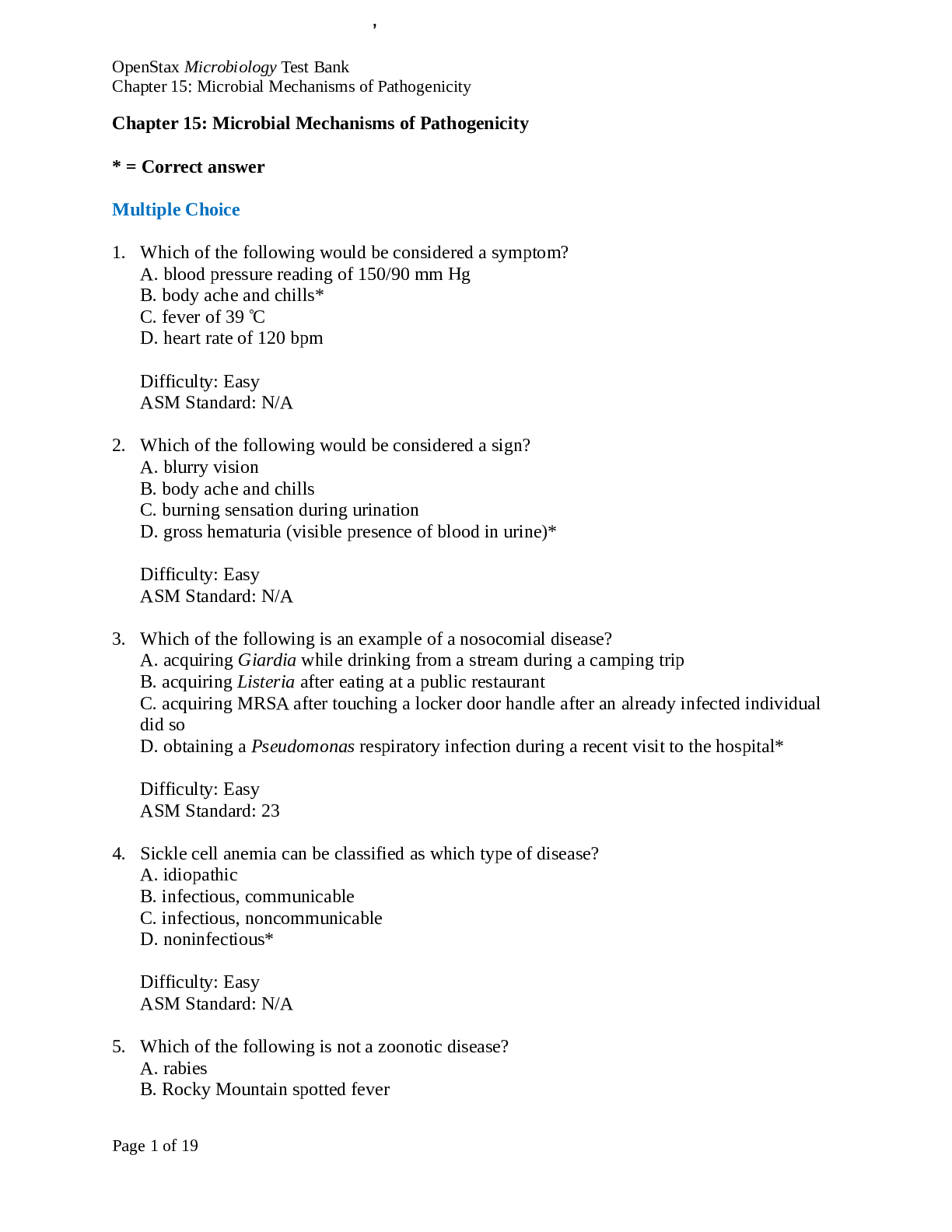Psychology > TEST BANKS > Test Bank for An Invitation to Social Psychology 1st Edition by Dale Miller (All)
Test Bank for An Invitation to Social Psychology 1st Edition by Dale Miller
Document Content and Description Below
Test Bank for An Invitation to Social Psychology 1st Edition by Dale T. Miller | 1.1 Characterizing Social Psychology A. Define social psychology and describe its value for our society 1.2 The Powe... r of the Situation A. Describe Kurt Lewin’s theory of the field of forces B. Explain what the Milgram experiment and the Good Samaritan study reveal about the power of the situation C. Define channel factors D. Define the fundamental attribution error 1.3 The Role of Construal A. Define construals and give some examples for construals of situations B. Define schemas and describe how they relate to social behavior and interaction 1.4 Automatic vs. Controlled Processing A. Distinguish between automatic processing and controlled processing 1.5 Evolution and Human Behavior: How We Are the Same A. Describe the evolutionary perspective on social behavior, including the emerging field of social neuroscience 1.6 Culture and Human Behavior: How We Are Different A. Distinguish between independent (individualistic) and interdependent (collectivistic) cultures, and explain how these cultural differences relate to the ways people think, feel, and behave 1.7 The Uses of Social Psychology A. Explain how social psychology can improve critical thinking. MULTIPLE CHOICE 1. Social psychology can be defined as the ________ study of the ________ of individuals in social situations. a. rational; feelings, thoughts, and behaviors b. scientific; behaviors c. scientific; feelings, thoughts, and behaviors d. behavioral; thoughts and feelings ANS: C DIF: Easy REF: 1.1 Characterizing Social Psychology OBJ: 1.1A MSC: Remembering 2. Social psychologists would be MOST likely to focus on which of the following potential causes underlying the military abuses at Abu Ghraib prison during the Iraq War? a. The soldiers who instigated these abuses were bad people. b. The power imbalance at the prison facilitated the soldiers’ bad behavior. c. American foreign policy encouraged anti-Arab behavior in many spheres. d. The soldiers were not in their right minds, having been traumatized by their experiences during the war. ANS: B DIF: Difficult REF: 1.1 Characterizing Social Psychology OBJ: 1.1A MSC: Applying 3. Sandra thinks that smiling a lot during a job interview increases a person’s chances of getting a job offer. The main difference between Sandra’s folk theory and social psychological theories is that social psychological theories are a. always more complicated. c. based on logic. b. almost always counterintuitive. d. tested using the scientific method. ANS: D DIF: Easy REF: 1.1 Characterizing Social Psychology OBJ: 1.1A MSC: Understanding 4. Which of the following statements about social psychology is the most accurate? a. Social psychologists rely primarily on correlational research. b. Social psychologists argue that genetics do not exert causal effects on social behavior. c. Social psychologists examine the influence of situations on behaviors. d. Social psychologists stress individual differences in behavior. ANS: C DIF: Moderate REF: 1.1 Characterizing Social Psychology OBJ: 1.1A MSC: Analyzing 5. Which of the following is LEAST characteristic of the goals of social psychology? a. understanding how people in different cultures think, feel, and behave b. understanding how people control each other’s behaviors c. evaluating the accuracy of folk theories about how situations influence behavior d. understanding how personality traits predispose people to respond to major events in their lives ANS: D DIF: Moderate REF: 1.1 Characterizing Social Psychology OBJ: 1.1A MSC: Analyzing 6. Which of the following phenomena best illustrates the relationship between social influence and behavior? a. acting more cooperative when you are in a good mood (as opposed to a bad mood) b. preferring to drive with the car radio on (as opposed to off) c. cycling faster when people are watching you (as opposed to when you are alone) d. getting into more arguments when the temperature is above 80 degrees (as opposed to under 80 degrees) ANS: C DIF: Difficult REF: 1.1 Characterizing Social Psychology OBJ: 1.1A MSC: Analyzing 7. What is the “field of forces” that Kurt Lewin emphasized in understanding human behavior? a. personal attributes c. underlying genetics b. social situations d. biological factors ANS: B DIF: Easy REF: 1.2 The Power of the Situation OBJ: 1.2A MSC: Remembering 8. Kurt Lewin’s concept of channel factors emphasizes how ________ rather than ________ shape(s) human behavior. a. childhood upbringing; genetic predisposition b. genetic predisposition; childhood upbringing c. subtle situational features; internal dispositions d. internal dispositions; subtle situational features ANS: C DIF: Moderate REF: 1.2 The Power of the Situation OBJ: 1.2C MSC: Analyzing 9. Kurt Lewin’s concept of the field of forces emphasizes that ________ underlie(s) much of human behavior. a. genetics c. the characteristics of a situation b. physical stimulation d. natural selection ANS: C DIF: Easy REF: 1.2 The Power of the Situation OBJ: 1.2A MSC: Understanding 10. Kurt Lewin, the founder of modern social psychology, argued that the effects of psychological forces can be understood in the same way that ________ forces are understood. a. physical c. personality b. attributional d. armed ANS: A DIF: Easy REF: 1.2 The Power of the Situation OBJ: 1.2A MSC: Understanding 11. Research on ________ suggests it is ________ for people to assume that dispositions are the underlying causes of most behaviors. a. the fundamental attribution error; common b. the fundamental attribution error; uncommon c. channel factors; common d. channel factors; uncommon ANS: A DIF: Easy REF: 1.2 The Power of the Situation OBJ: 1.2D MSC: Remembering 12. The classic Milgram study showed that about ________ percent of participants delivered ________ to the “learner.” a. 1; a 330-volt shock or higher (i.e., after the learner let out an agonized scream) b. 10; no shocks c. 20; a 450-volt shock (highest possible) d. 60; a 450-volt shock (highest possible) ANS: D DIF: Moderate REF: 1.2 The Power of the Situation OBJ: 1.2B MSC: Remembering 13. According to social psychologists, which of the following conditions is most likely to make someone do what an authority figure says to do, even if it involves hurting someone? a. when people know ahead of time that an authority figure will be ordering them around b. when people have been raised in abusive families c. when people can hold an authority figure responsible for his or her actions d. when people are used to hurting other people ANS: C DIF: Moderate REF: 1.2 The Power of the Situation OBJ: 1.2B MSC: Understanding 14. The Good Samaritan study conducted by Darley and Batson (1973) examined helping behavior in seminary students at Princeton University. These students were either rushed or not rushed to get to an appointment. The results of this study showed that a. participants who viewed religion as a means toward personal salvation were less likely to help a person in need than participants who viewed religion as a means to develop moral and spiritual values. b. when rushed, only participants who viewed religion as a means for personal salvation were less likely to help a person in need. c. when rushed, only participants who viewed religion as a means to develop moral and spiritual values were less likely to help a person in need. d. the nature of participants’ religious orientations did not predict helping behavior; only whether or not they were rushed predicted whether they helped a person in need. ANS: D DIF: Moderate REF: 1.2 The Power of the Situation OBJ: 1.2B MSC: Understanding 15. Your waiter seems to be doing everything wrong. He has forgotten to take your drink order. He delivers someone else’s food to your table. He does not come out and say it, but his facial expressions seem to say he would rather be someplace else. If you assume his behavior is caused primarily by ________, your assumption is consistent with the fundamental attribution error. a. channel factors c. his disposition b. situational factors he can control d. situational factors beyond his control ANS: C DIF: Easy REF: 1.2 The Power of the Situation OBJ: 1.2D MSC: Understanding 16. Which of the following scenarios is LEAST consistent with the fundamental attribution error? a. When someone swerves into your lane while driving, you think to yourself, “This person is a terrible driver!” b. When someone at a party smiles at you, you think to yourself, “This person smiles at everyone.” c. When you slip and fall down at a shopping mall, you think to yourself, “I was born clumsy!” d. When someone talks loudly to his or her friend on the bus, you think to yourself, “This person might be talking to someone who has a hearing problem.” ANS: D DIF: Difficult REF: 1.2 The Power of the Situation OBJ: 1.2D MSC: Analyzing 17. The president of a fraternity wants to increase the number of fraternity members who volunteer for nonprofit organizations in the community. Which of the following strategies would BEST fit with Kurt Lewin’s concept of channel factors? a. induce guilt among members who are not currently volunteering b. leave information about when and how members might volunteer on the counter c. offer a prize to the member who volunteers the most hours d. ask members to publicly commit to a particular volunteer opportunity ANS: B DIF: Difficult REF: 1.2 The Power of the Situation OBJ: 1.2C MSC: Applying 18. Which of the following concepts is most relevant to people who want to make someone act on his or her intentions? a. channel factors c. tension systems b. the fundamental attribution error d. naturalistic fallacy ANS: A DIF: Easy REF: 1.2 The Power of the Situation OBJ: 1.2C MSC: Applying 19. Marco, a physics major, and Tim, a social work major, always take the school bus together. Today the bus was delayed. Tim is going to be late for a midterm, whereas Marco does not have class for the first few hours. While walking from the bus stop, Marco and Tim pass a woman crying on a bench. According to Darley and Batson’s Good Samaritan study, how are Marco and Tim likely to behave? a. Marco is more likely to help the woman, given that he does not have to rush to a midterm. b. Tim is more likely to help the woman because he will feel especially heroic helping her despite being in a rush. c. As a social work major, Tim is more likely to help the woman. d. As a physics major, Marco is more likely to help the woman. ANS: A DIF: Difficult REF: 1.2 The Power of the Situation OBJ: 1.2B MSC: Applying 20. What do the results of the Milgram experiment and Darley and Batson’s Good Samaritan study have in common? a. Both highlight the power of the situation in determining behavior. b. Both highlight how people respond differently to the same situation. c. Both highlight cultural differences in behavior. d. Both highlight universality in behavior across cultures. ANS: A DIF: Difficult REF: 1.2 The Power of the Situation OBJ: 1.2B MSC: Analyzing [Show More]
Last updated: 8 months ago
Preview 10 out of 186 pages

Loading document previews ...
Buy this document to get the full access instantly
Instant Download Access after purchase
Buy NowInstant download
We Accept:

Reviews( 0 )
$13.00
Can't find what you want? Try our AI powered Search
Document information
Connected school, study & course
About the document
Uploaded On
Sep 25, 2022
Number of pages
186
Written in
Additional information
This document has been written for:
Uploaded
Sep 25, 2022
Downloads
0
Views
80








.png)















